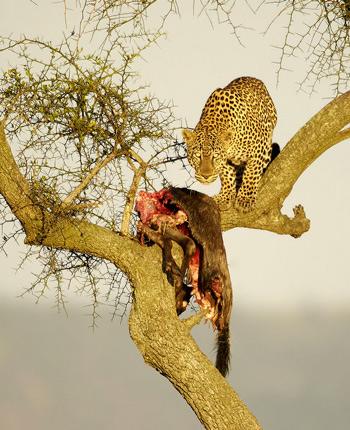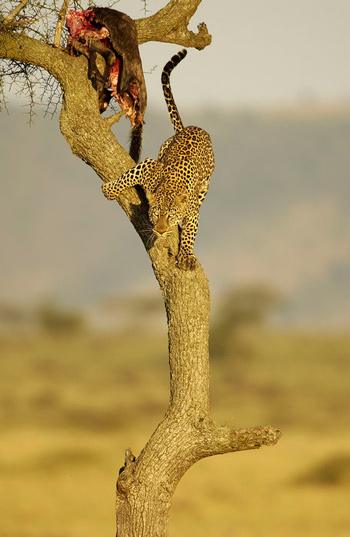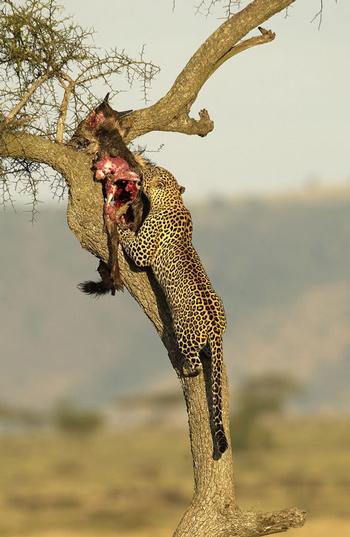Leopard In A Tree
By Len Backus
"Leopard in a tree!" was Hassan's urgent utterance. It was the seventh morning of our Kenya photo safari. Hassan was driving west toward the area where we had been shooting a cheetah family quite late the afternoon before. A little way further down the gravel road we stopped within perfect 600 mm lens distance from the big male cat.The sun had cleared the top of the hills behind us only twenty minutes earlier and the golden light was perfect in its direction.

My photo partner, Jack Sullivan, and I had been amazed at each successively better photo op as our full days in the Masai Mara passed quickly. But come on, now. This was getting ridiculous! Imagine making a wish list. "Let's find a second leopard." We had shot one four days earlier and marveled at our luck that day. Most Mara travelers see not even one leopard. "Let's find our second leopard in a non-typically open-branched acacia tree so we have a clear shot. Maybe we could find one with its prey clearly visible next to it. We'll need a clean background. You know how fussy those ardent photographers are about backgrounds when you post an image on the critique forum. Oh, and I just hope we don't find our second leopard on a cloudy day."
But no, this was going to be much better! After taking one hundred three images on my 512 meg flash card I would later just look at Jack and shake my head in disbelief at our incredible good fortune. Our cooperative subject was perched high in the thorny tree on a branch about as thick as my thigh. The remains of an unlucky young wildebeest were draped neatly over the branch just inches from the cat's sharp claws. Leopards are efficient, stealthy killers but they need to store their uneaten groceries in a tree to hide the leftover food from lions, hyenas, jackals and vultures. Sometimes at home I make an after-supper dessert run to my nearby Open Pantry convenience store. After gorging on as much as my diet will allow, I sometimes hide my remaining sweet treats up high on the top shelf? away from my college-attending son. I can relate to the problems of a leopard!
The black-centered yellow eyes of the leopard locked on mine through the 600 mm lens as my D1X fired off a series of quick insurance shots. I fully expected him to be gone in a flash?into the tall grass at the base of the tree. He sniffed at the carcass and then started slowly working his way down the tree. He paused several times, seeming to enjoy posing for the camera. Finally he reached the bottom where he crouched in the tall grass, seemingly uncertain whether he really wanted to abandon his prey high above.

I said to Jack, assuming the best of the moment was over. About then I noticed a hot-air balloon against the rich, blue sky over my right shoulder. Gliding slowly, it would eventually pass right behind our tree. With the leopard still on the ground below, I shot a series of the brightly colored balloon as it finally passed behind the tree making a surreal backdrop for the dead wildebeest wedged in the crotch of the acacia tree. I wondered if the passengers in the large wicker basket could see what was going on below them. If the leopard had still been in the tree, my shot would have interested the marketing departments of quite a few hot-air balloon companies throughout East Africa. It was an interesting and colorful shot, nonetheless.

Just then a vulture appeared, gliding slowly and purposefully just above our tree. Usually a leopard stores its food in a densely branched tree to hide it from cruising vultures. But this leopard had made his kill far from any such trees and had settled for our tree. Now he was up on his feet, nervously watching the flight of the vulture. In another moment, and to our further amazement, he started slowly back up toward his pantry in the tree. He was now worried about losing his food supply to the vulture. His movements upward were smooth and powerful, his muscles rippling under the beautifully spotted coat. We could see how full his belly was. While still on the ground much of the weight of the wildebeest had earlier been transferred to the leopard?s stomach. Thus, the original climb had been manageable when he had first scaled the tree with the already lightened wildebeest remains in his mouth.
Just before he reached the top he paused, turning toward the camera. He placed his four feet together on the side of the slanting tree trunk and seemed to pose for us. The way his feet came together reminded me of a performing elephant balancing on that silly, squat stand they use in the center ring of a circus. Satisfied that we must have gotten good shots of him, he now turned away from the cameras and stretched his neck and head toward the carcass. His open jaws clamped down on the lower part of the wildebeest and he started tugging it toward himself, again and again. As he tugged, his body was stretched out quite far. Then the carcass broke free and dropped downward, landing in the lap of the leopard.

With the big cat backing a few feet further down the tree, the wildebeest became lodged on top of a stubby broken-off branch. The now perfectly balanced leopard with his neatly looped tail again looked right at the camera as if to say: "Now what do I do?" The head, tail and legs of the wildebeest dangled perfectly from the snag. Next the cat's mouth opened wide and he grabbed the shoulder of the wildebeest and started pulling again. I remember thinking that his jaws were now open so wide that Jack's entire head would have fit inside.
He backed sort of sideways down the tree a ways with the carcass in his mouth but it was still stuck on the branch. Finally, from underneath he gave one more big pull and the wildebeest was dislodged. It fell so abruptly that it knocked the cat off the tree and to the ground five more feet below. Undaunted, the leopard picked up one end of the carcass and dragged it about one hundred feet to a culvert under the road where it quickly disappeared from our sight and away from the vulture?s hungry eyes.
With the leopard gone, we all three jabbered on and on about how lucky we had just been. How could we possibly ever top this photo op in Kenya? Hassan then drove off slowly in the direction of yesterday's cheetah family. Ten minutes later we came upon our cheetahs perched in a leaned-over tree. The mom, from on high in the tree, was gazing off into the distance in a classic hunting pose. Over the next four hours we followed them, watching and photographing three kills. The third gazelle captured by the cheetah mom was handed over to the cubs for practice. Twice the student cubs played with the baby gazelle, released it, ran it down and caught it again. But that's a story for another day!
Surely, when we return to Kenya this fall we won't be able to top these encounters...or will we?
Len is the owner of www.LongRangeHunting.com. He has been a long range hunter since the nineties. He is as likely to bag his game with a camera as with a rifle or handgun.
By Len Backus
"Leopard in a tree!" was Hassan's urgent utterance. It was the seventh morning of our Kenya photo safari. Hassan was driving west toward the area where we had been shooting a cheetah family quite late the afternoon before. A little way further down the gravel road we stopped within perfect 600 mm lens distance from the big male cat.The sun had cleared the top of the hills behind us only twenty minutes earlier and the golden light was perfect in its direction.

My photo partner, Jack Sullivan, and I had been amazed at each successively better photo op as our full days in the Masai Mara passed quickly. But come on, now. This was getting ridiculous! Imagine making a wish list. "Let's find a second leopard." We had shot one four days earlier and marveled at our luck that day. Most Mara travelers see not even one leopard. "Let's find our second leopard in a non-typically open-branched acacia tree so we have a clear shot. Maybe we could find one with its prey clearly visible next to it. We'll need a clean background. You know how fussy those ardent photographers are about backgrounds when you post an image on the critique forum. Oh, and I just hope we don't find our second leopard on a cloudy day."
Well, that's about as wild as my imagination could
have gotten if I had taken the time to think about it.
have gotten if I had taken the time to think about it.
The black-centered yellow eyes of the leopard locked on mine through the 600 mm lens as my D1X fired off a series of quick insurance shots. I fully expected him to be gone in a flash?into the tall grass at the base of the tree. He sniffed at the carcass and then started slowly working his way down the tree. He paused several times, seeming to enjoy posing for the camera. Finally he reached the bottom where he crouched in the tall grass, seemingly uncertain whether he really wanted to abandon his prey high above.
"Well, that was quite a lucky encounter",

I said to Jack, assuming the best of the moment was over. About then I noticed a hot-air balloon against the rich, blue sky over my right shoulder. Gliding slowly, it would eventually pass right behind our tree. With the leopard still on the ground below, I shot a series of the brightly colored balloon as it finally passed behind the tree making a surreal backdrop for the dead wildebeest wedged in the crotch of the acacia tree. I wondered if the passengers in the large wicker basket could see what was going on below them. If the leopard had still been in the tree, my shot would have interested the marketing departments of quite a few hot-air balloon companies throughout East Africa. It was an interesting and colorful shot, nonetheless.

Just then a vulture appeared, gliding slowly and purposefully just above our tree. Usually a leopard stores its food in a densely branched tree to hide it from cruising vultures. But this leopard had made his kill far from any such trees and had settled for our tree. Now he was up on his feet, nervously watching the flight of the vulture. In another moment, and to our further amazement, he started slowly back up toward his pantry in the tree. He was now worried about losing his food supply to the vulture. His movements upward were smooth and powerful, his muscles rippling under the beautifully spotted coat. We could see how full his belly was. While still on the ground much of the weight of the wildebeest had earlier been transferred to the leopard?s stomach. Thus, the original climb had been manageable when he had first scaled the tree with the already lightened wildebeest remains in his mouth.
Just before he reached the top he paused, turning toward the camera. He placed his four feet together on the side of the slanting tree trunk and seemed to pose for us. The way his feet came together reminded me of a performing elephant balancing on that silly, squat stand they use in the center ring of a circus. Satisfied that we must have gotten good shots of him, he now turned away from the cameras and stretched his neck and head toward the carcass. His open jaws clamped down on the lower part of the wildebeest and he started tugging it toward himself, again and again. As he tugged, his body was stretched out quite far. Then the carcass broke free and dropped downward, landing in the lap of the leopard.

With the big cat backing a few feet further down the tree, the wildebeest became lodged on top of a stubby broken-off branch. The now perfectly balanced leopard with his neatly looped tail again looked right at the camera as if to say: "Now what do I do?" The head, tail and legs of the wildebeest dangled perfectly from the snag. Next the cat's mouth opened wide and he grabbed the shoulder of the wildebeest and started pulling again. I remember thinking that his jaws were now open so wide that Jack's entire head would have fit inside.
He backed sort of sideways down the tree a ways with the carcass in his mouth but it was still stuck on the branch. Finally, from underneath he gave one more big pull and the wildebeest was dislodged. It fell so abruptly that it knocked the cat off the tree and to the ground five more feet below. Undaunted, the leopard picked up one end of the carcass and dragged it about one hundred feet to a culvert under the road where it quickly disappeared from our sight and away from the vulture?s hungry eyes.
With the leopard gone, we all three jabbered on and on about how lucky we had just been. How could we possibly ever top this photo op in Kenya? Hassan then drove off slowly in the direction of yesterday's cheetah family. Ten minutes later we came upon our cheetahs perched in a leaned-over tree. The mom, from on high in the tree, was gazing off into the distance in a classic hunting pose. Over the next four hours we followed them, watching and photographing three kills. The third gazelle captured by the cheetah mom was handed over to the cubs for practice. Twice the student cubs played with the baby gazelle, released it, ran it down and caught it again. But that's a story for another day!
Surely, when we return to Kenya this fall we won't be able to top these encounters...or will we?

